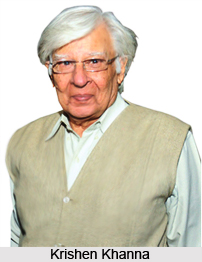 Krishen Khanna was born in 1925 in Lyallpur, now Faisalabad in Pakistan. Krishen Khanna moved to Shimla during the partition. He had attended evening classes at the Mayo School of Art in Lahore. Khanna studied at the Imperial Service College, Windsor, England, from where he graduated in 1940. After arriving in India he took up a post with the Grindlays Bank and was placed in the city of Mumbai. Khanna was invited to join the Progressive Artists` Group with who he remained in active association. His early works are reproductions of the scenes that were imprinted in his memory during this period.
Krishen Khanna was born in 1925 in Lyallpur, now Faisalabad in Pakistan. Krishen Khanna moved to Shimla during the partition. He had attended evening classes at the Mayo School of Art in Lahore. Khanna studied at the Imperial Service College, Windsor, England, from where he graduated in 1940. After arriving in India he took up a post with the Grindlays Bank and was placed in the city of Mumbai. Khanna was invited to join the Progressive Artists` Group with who he remained in active association. His early works are reproductions of the scenes that were imprinted in his memory during this period.
Khanna was awarded the Rockefeller Fellowship in 1962. He has participated in group shows like the Tokyo Biennale 1957 and 196 1, the Sao Paulo Biennale 1960, the Venice Biennale 1962, the Festival of India in the then USSR and in Japan in 1987 and 1988. Khanna`s masterful deployment of paint evoked the human situation which is unmatched. The thick impasto surface often seems like a prism through which figures can be discerned.
His works are figurative. His work captures moments in history but the artist`s technique is far from photo-realist. He transfers with spontaneity his observations onto the canvas maintaining the representational elements of his subject. Recognizing his contribution to Indian Art, the Government of India has bestowed several honours upon him including the Lalit Kala Ratna from the President of India in 2004 and the Padma Shri in 1990. He won a fellowship from the Council for Economic and Cultural Affairs, New York following the travel grant they had awarded him in 1962.
This article is a stub. You can enrich by adding more information to it. Send your Write Up to content@indianetzone.com



















